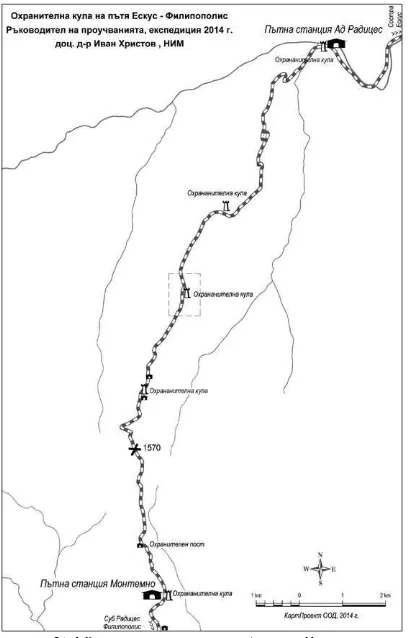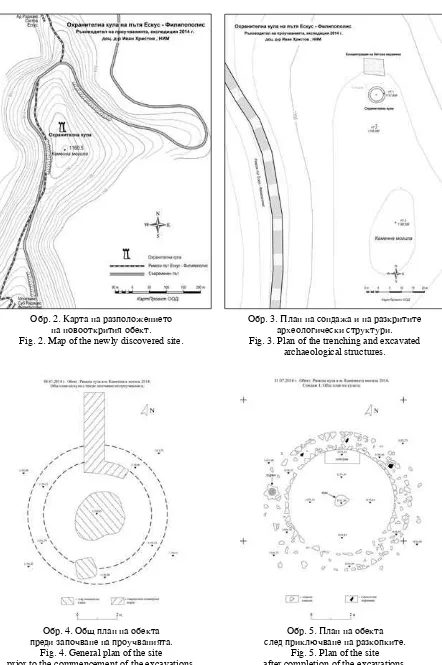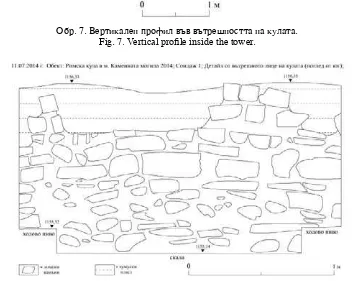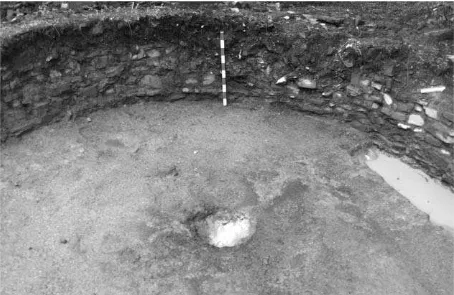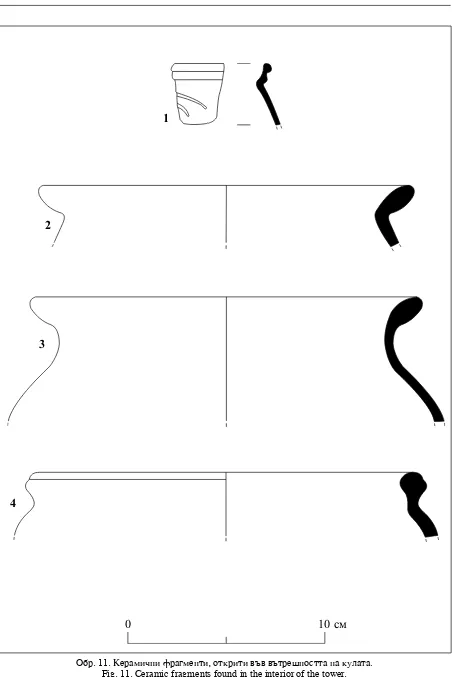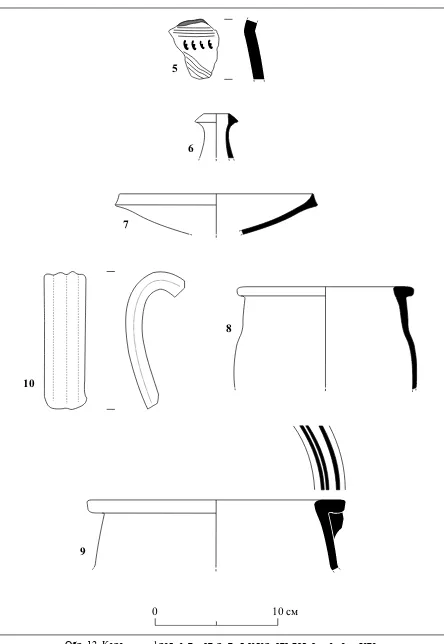Проучване на Шеста рИмска наБлюдателна кула (TURRIS)
на Пътя аD RADICES – мONTEMNO
Иван Христов
A STUDY OF THE SIXTH ROMAN WATCHTOWER (TURRIS)
ON THE ROAD AD RADICES – MONTEMNO
Ivan Hristov "Kamennata mogila" (Fig. 1–2–3). the area rep-resents an elevation of 1160 m asl, 50 meters to the east of the route of the roman road between the stations Ad radices and Montemno1. because
of the real danger the ancient site to be completely devastated, rescue excavations were conducted in july 20142.
the excavations were carried out within a test trench sized 7 x 8 meters set on a small round-shaped hill with a pileup of stones on the surface.
1 the roman roadside station Ad radices is localized in the Kamen most site at the southern outskirts of the town of troyan. the steep north ascent of the mountain actually begins from this station. Montemno is localized by Mitko Madjarov in the vicinity of the tourist town of beklem-eto situated near the troyan Pass on the north side of the mountain ridge. In my opinion, this localisation is incor-rect because of the fact that the excavations uncovered in the site only a watchtower and an open camp that cor-respond to the situation described in the article. I also as-sume on the basis of archaeological excavations in the area that Montemno itself was situated in the locality of "Vlashki mandri". there, besides the towers we revealed the foundations of a large building of several rooms, frag-ments of a commemorative inscription and others. See the discussion at: маджаров, м. римският път ескус
възвишение с кръгла форма и натрупани на
по-In the northern periphery of the hill, the looters’ digging had revealed the inner face of an antique structure (Fig. 4). the vegetation and low shrubs on the terrain were cleared away and a round structure with an inner diameter of 5,50 m and 0,70 m thickness of the walls was uncovered in the test trench (Fig. 5–6). the excavations were conducted inside the supposed tower as initially a 0.60 m wide control rib was left. the excavation of the northern arc of the site provided informa-tion on the stratigraphy of the ancient site (Fig. 7). old treasure hunters’ diggings were visible in the middle of the hill and its southern periphery. In all probability, the diggers had thought the site a stone thracian tomb.
In vertical plan, we documented a 0,40 m thick humus layer, fallen stones of the masonry and a thin layer in which small fragments of roman pottery, coal and metal objects were found. during the excavations south of the control rib we found out that the tower walls were built of a local stone breed (‘leska’) and this was conirmed when the rib was later excavated. Most of the stones bore traces of careful processing in the form of small blocks of different sizes. the foundations of the tower were dug into the ground at a depth of only 0,30 m below the layer containing the artifacts that marked the loor level of the structure. Holes for mounting wooden scaffolding were documented in the inner north wall; the height at which the walls were preserved was maximum 0,90 m (Fig. 8–9).
Perhaps the tower was entered from the west or south, but because of the ruins along the pe-riphery it was dificult to identify the entrance. during the complete excavation of the site a round pit with a diameter of 0,30 m was uncovered right in the middle of the loor. the pit was dug into the sterile rocky terrain. Perhaps it served for a large wooden support beam to be placed in it (Fig. 10).
червенолакова керамика. откритите
керамич-Augusta trajana / Stara zagora. – rCrF, Acta XXIX/ XXX, 1991, 245–273.
8 кабакчиева, Г. керамика от вилата при
Ивайлов-град, II–IV в. – разкопки и проучвания. книга 15. София, 1986, 86, 94–97.
9 Popilian, G. цит. съч.
fragment of this group belongs to a cup of barbot-ine decoration dating from the 2nd–3rd c. (Fig. 11).
the fragment has parallels to the pottery from the roman ceramic centres at butovo and Pavlikeni, Velikotarnovo region3; from the roman villa near
the village of Kralev dol, Pernik region4; the
mili-tary barracks in the castle of Sostra (unpublished materials) and from different sites in the province of dacia5.
the gray-black pottery (70%) was made of clay mixed with large and small sand particles with gray-black surface obtained after iring. Some fragments correspond with the unearthed pottery from the roman defense tower in "Kartzov buk" locality in the troyan Pass6; the necropolis of
Augusta traiana7; villa "Armira"8; the province of
dacia9.
generally the potsherds can be dated to the
3rd – early 4th c.
the analysis of the archaeological material allows us to determine the time when the watch structure was abandoned – probably in the
mid-3rd c., because of the massive gothic invasions.
the construction of the tower can be generally at-tributed to the 2nd c. Such is the chronology of the
neighbouring round watch structures on the road to Philippopolis.
Numerous treasure hunters’ diggings and a concentration of building and household roman pottery from the 2nd–3rd centuries were recorded
on a 40 sq.m. area at the northern foot of the site. this situation could be related to a supposed
aux-3 Sultov, b. Ceramic Production on the territory of
блюдателни обекти с кръгъл план по пътя за
iliary structure to the tower.
In this section a severely worn coin of emperor Hadrian was found, that was minted in one of the cities in the province of thracia as well as 131 fragments of hand-made pottery (1%), red-lacquered (64%) and gray-black pottery (35%) (Fig. 12–13). the pottery consisted of jugs, cups, pots and lids again generally dating back to the
2nd–3rd c. and with close parallels from sites along
the roman road northwards to oescus as well as from the ceramic centres in Nicopolis ad Istrum, Villa Armira, the necropolis of Augusta traiana and others10.
the discovered site in the "Kamennata Mogila" locality can be interpreted as an roman watchtower – turris. this term is used in the bulgarian academic literature to denote the small-est independent fortiications performing police functions and observation of key roadside loca-tions in the empire. τύρσις a word from which the Latin turris (πύργος – tower) is derived, marked any solid building surrounded by walls. In old Latin, turris seems to have been equivalent to UrbS (Polyb. XXVI.4). Information on the use of small towers by the greeks and romans we ind in the classical literature. they are often mentioned by ancient authors as forming by them-selves places of residence and defense. this use of towers is very common in North Africa (diod. Sic. III.49, ItIN. Ant. Pp34, 35). examples are provid-ed by the tower of Hannibal in his estate between Acholla and thapsus (Liv. XXXIII.48), the turris in the territory controlled by jugurtha (Sallust. jug.
10 Иванова-камишева, M. керамични и стъклени съ-Production on the territory of Nicopolis ad Istrum (2nd–
"кли-ритория на югурта (Sallust. jug. 103), кула-roman Antiquities, john Murray, London, 1875.
12 Христов, Ив. / Иванова-камишева, м. / стой-нов, П. цит. съч., 1–156; Христов, Ив. Ad radices. римска крайпътна станция на пътя ескус – филипо-полис. София, 2012.
103), the tower of a private citizen near Carthage, the towers with which Scipio managed to conquer Carthage (Appian. Pun 117.); the tower in Spain (Appian. HISP. 16). on the other hand the term is used for towers located in the border provinces of the roman empire (Ammian. Marcell XXVIII.2). the term denotes both ixed defense structures and mobile towers used in the siege of fortresses (πύργοι πτύκτοι or πτυγμένοι, turres plicatiles, or portable towers, φορητο πυργο). Known to-ponyms are: tyrris Muca recorded in an inscrip-tion from the region of tomis in the province of Scythia and turris tamalleni in the province of Africa by the road from tacape to Leptis Magna. (Itin. Ant. Pp 73, 74)11.
According to S. torbatov the main purpose of the small towers was the area surveillance and warning of impending raids. the structures were capable of providing protection against sudden attacks by lean enemy squads (small military re-connaissance groups or robbers on the roads and passages – I.H.), but they were not designed for long-term defense.
Naturally, against a larger and organized en-emy, the garrison in the towers used to withdraw to the base camps.
there are other deinitions of the structure as burgus and munitio, but they do not essentially change the meaning of the newly discovered site at the northern foot of the troyan Pass.
two thoroughly explored towers of circular plan, a rectangular tower and three other tow-ers of supposed rectangular plans situated along the roman road to Philippopolis in the segment Sostra – Sub radice12 may be given as parallels
from the present day bulgarian lands. outside the discussed area, a Late Antiquity watchtower near the Pomoshtnik village, galabovo municipality, was studied by V. dinchev13. Another
rectangu-lar tower from Late Antiquity was discovered by
11 торбатов, с. функционално и типологическо
съ-държание на късноантичната фортификационна терминология. – археологически вести, 2000, №1, приложение №3, 24–27; A dictionary of greek and roman Antiquities, john Murray, London, 1875.
е проучена от в. динчев13. правоъгълна кула
15 Petrikovits, H. Fortiications in the North-western
ro-man empire from the third to the Fifth Centuries Ad. – the journal of roman Stdies, vol. 61, 1971, с. 180;
Jonson, S. Late roman Fortiications. batsford, Lon-don, 1983, 138–142; Gichon, M. the Hinterland of the Limes Palestinae – remains and written evidence. – N. gudea (ed.). Proceedings of the XVII International Congress of roman Frontier Studies. zalau, 1999, 667– 686; Vasic, M. / Milocevic, G. Mansio Idimum. rimska postanska i putna stanica kod medvede. beograd, 2000, с. 139; Jęczmienowski, е. the Fortiications of the Upper Moesian Limes. topography, Forms, garrison. – Sizesswiatowit annual of the institute of archaeology of the university of warsaw, Vol. X (li) (2012), Fascicle a, warszawa, 2013, 31–57.
16 Jęczmienowski, е. цит. съч., с. 48. 17 торбатов, с. цит. съч.
P. banova during the excavations of the roman roadside station Ad Putea at the village of riben, Pleven region14.
Certain defensive structures throughout the empire can be provided as parallels to the towers in the troyan Pass. there, however, the circular plan is rarely found15.
based on the size of the defense structures, some authors have proposed a numerical strength of the soldiers who served in the towers16. In this
case, the defence of the tower was secured prob-ably by a small unit, contubernium, consisting of eight soldiers17.
the publication of the excavation results sup-plied with a complete catalogue of the inds is jus-tiied because of the rare occasion a watchtower from the roman era to be localized and examined in the context of the route of one of the important military roads in the empire that connected the province of thracia with Moesia Inferior.
14 Бънов, П. Спасителни археологически разкопки "ад
путеа 2013", с. рибен, общ. долна митрополия, об-ласт плевен – аор през 2013, София 2014, 330–333.
15 Petrikovits, H. Fortiications in the North–western
roman empire from the third to the Fifth Centuries Ad. – the journal of roman Stdies, vol.61, 1971, 180;
Jonson, S. Late roman Fortiications. batsford, Lon-don, 1983, 138–142; gichon, M. the Hinterland of the Limes Palestinae – remains and written evidence. – N. gudea (ed.). Proceedings of the XVII International Congress of roman Frontier Studies. zalau, 1999, 667– 686; Vasic, M. / Milocevic, G. Mansio Idimum. rim-ska postanrim-ska i putna stanica kod medvede. beograd, 2000, 139; Jęczmienowski, E. the Fortiications of the Upper Moesian Limes. topography, Forms, garrison. Sizesswiatowit annual of the institute of archaeology of the university of warsaw, Vol. X (li) (2012), Fascicle a, warszawa 2013, 31–57.
16 Jęczmienowski, E. the Fortiications of the Upper
Moesian Limes. topography, Forms, garrison. Sizess-wiatowit annual of the institute of archaeology of the university of warsaw, Vol. X (li) (2012), Fascicle a war-szawa 2013, 48.
17 торбатов, с. функционално и типологическо
съ-държание на късноантичната фортификационна терминология. – археологически вести, 2000, №1, приложение №3, 6.
обр. 2. карта на разположението на новооткрития обект. Fig. 2. Map of the newly discovered site.
обр. 3. план на сондажа и на разкритите археологически структури. Fig. 3. Plan of the trenching and excavated
archaeological structures.
обр. 4. общ план на обекта преди започване на проучванията.
Fig. 4. general plan of the site prior to the commencement of the excavations.
обр. 5. план на обекта след приключване на разкопките.
обр. 8. детайли от вътрешното лице на кулата. Fig. 8. details of the inner surface of the tower. обр. 6. основи на кулата – поглед от югоизток. Fig. 6. Foundations of the tower – view from southeast.
обр. 10. кръгла яма в средата на кулата. Fig. 10. round pit in the middle of the tower. обр. 9. детайли от вътрешното лице на кулата.
0
10 см
1
2
3
4
0 10 см 5
6
7
8
9 10
№ описание bronze buckle from a belt
дължина 1,4 см
of emperor Hadrian диаметър 2,1 см тегло 6,9 г of the tower in a layer
with ceramic fragments; 2nd–3rd c.
5 (4 Assaria). Circa A.d. 211–217.
Magistrate quintillianus.
Moesia Inferior. Magistrate ovinius tertullus. M AVP ANtΩNINoC, Processed horn for a tool
дължина 7 см in the earth thrown out.
9
Сребърен денарий на император Септимий Север
Silver denarius of emperor Septimius Severus
Septimius Severus denarius, rIC 288, rSC 606, bMC 359 Septimius Severus denarius. 201–210 Ad.
SeVerVS PIVS AVg, laureate head right / reStItVtor VrbIS, roma seated left holding palladium & spear, round sheild
below. rSC 606.
диаметър 1,7 см; тегло 2,3 г diameter 1,7 cm;
weight 2,3 g
1
Сондаж №1 СИ∠4,90 м;
юз∠6,90 м;
1155,45 м.н.в. test trench №1 Ne∠4,90 m;
Sw∠6,90 m;
1155,45 m asl.
10
желязна тока с врязана украса
Iron buckle with incised decoration височина 4,5 см; дължина при основата 4,5 см
height 4,5 cm; length at the base
4,5 cm
1
Северното подножие на кулата в пласт
със строителна римска керамика
Northern foot of the tower in a layer with roman building
